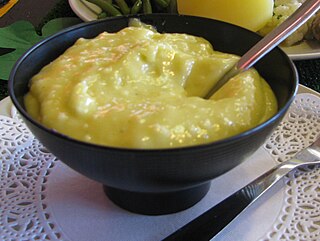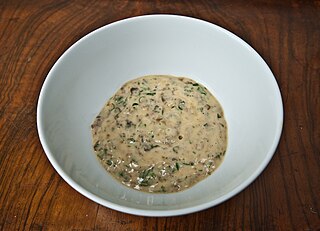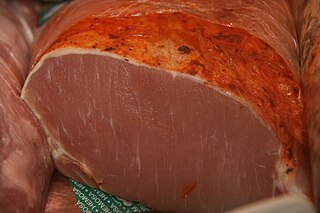
Tomato sauce can refer to many different sauces made primarily from tomatoes, usually to be served as part of a dish, rather than as a condiment. Tomato sauces are common for meat and vegetables, but they are perhaps best known as bases for sauces for Mexican salsas and Italian pasta dishes. Tomatoes have a rich flavor, high water content, soft flesh which breaks down easily, and the right composition to thicken into a sauce when stewed, without the need for thickeners such as roux or masa. All of these qualities make them ideal for simple and appealing sauces.

Aioli, allioli, or aïoli is a cold sauce consisting of an emulsion of garlic and olive oil; it is found in the cuisines of the northwest Mediterranean.

Tzatziki, also known as cacık or tarator, is a class of dip, soup, or sauce found in the cuisines of Southeastern Europe and West Asia. It is made of salted strained yogurt or diluted yogurt mixed with cucumbers, garlic, salt, olive oil, red wine vinegar, sometimes with lemon juice, and herbs such as dill, mint, parsley and thyme. It is served as a cold appetiser (meze), a side dish, and as a sauce for souvlaki and gyros sandwiches and other foods.

Fried rice is a dish of cooked rice that has been stir-fried in a wok or a frying pan and is usually mixed with other ingredients such as eggs, vegetables, seafood, or meat. It is often eaten by itself or as an accompaniment to another dish. Fried rice is a popular component of East Asian, Southeast Asian and certain South Asian cuisines, as well as a staple national dish of Indonesia. As a homemade dish, fried rice is typically made with ingredients left over from other dishes, leading to countless variations. Fried rice first developed during the Sui dynasty in China.

Rémoulade is a cold sauce. Although similar to tartar sauce, it is often more yellowish, sometimes flavored with curry, and often contains chopped pickles or piccalilli. It can also contain horseradish, paprika, anchovies, capers and a host of other items.

Adobo or adobar is the immersion of food in a stock composed variously of paprika, oregano, salt, garlic, and vinegar to preserve and enhance its flavor. The Portuguese variant is known as carne de vinha d'alhos. The practice, native to Iberia, was widely adopted in Latin America, as well as Spanish and Portuguese colonies in Africa and Asia.

A dip or dip sauce is a common condiment for many types of food. Dips are used to add flavor or texture to a food, such as pita bread, dumplings, crackers, chopped raw vegetables, fruits, seafood, cubed pieces of meat and cheese, potato chips, tortilla chips, falafel, and sometimes even whole sandwiches in the case of jus. Unlike other sauces, instead of applying the sauce to the food, the food is typically placed or dipped into the sauce.

Chili sauce and chili paste are condiments prepared with chili peppers.

Mujdei is a traditional spicy Romanian sauce. It is made from garlic cloves crushed and ground into a paste, salted and mixed energetically with vegetable oil. Depending on regional preferences and the dish it is served with, lemon or other ingredients may be added. The result is a white sauce with a strong garlic flavor, varying in consistency from a thick paste to a runny sauce. In some parts of Romania mujdei is made out of cream, ground garlic, and salt. Sometimes ground garlic, salt, little water, oil and paprika powder.

Salsat toum, also known as toumya or simply toum, is a garlic sauce common to the Levant. It is similar to the Provençal aioli, but the proportion of garlic is much higher. There are many variations, a common one containing garlic, salt, olive oil or vegetable oil, and lemon juice, traditionally crushed together using a wooden mortar and pestle. There is also a popular variation in Lebanon where mint is added; it is called zeit wa toum.

Harissa is a hot chili pepper paste, native to the Maghreb. The main ingredients are roasted red peppers, Baklouti peppers (بقلوطي), spices and herbs such as garlic paste, caraway seeds, coriander seeds, cumin and olive oil to carry the oil-soluble flavors.

Ivorian cuisine is the traditional cuisine of Côte d'Ivoire, or the Ivory Coast, and is based on tubers, grains, pig, chicken, seafood, fish, fresh fruits, vegetables and spices. It is very similar to that of neighboring countries in West Africa. Common staple foods include grains and tubers. Côte d'Ivoire is one of the largest cocoa producers in the world and also produces palm oil and coffee.

Agliata is a pungent, savoury garlic sauce and condiment in Italian cuisine used to flavour and accompany grilled or boiled meats, fish and vegetables. It is first attested in ancient Rome, and it remains part of the cuisine of Liguria. Porrata is a similar sauce prepared with leeks in place of garlic.

Derssa is a popular condiment in Algerian cuisine, which is typically made with garlic, cumin, red chili pepper flakes, and olive oil. It is often served alongside grilled or roasted meats, and also used as a marinade for meat or vegetables before cooking. It is a versatile condiment and is often used to add flavor to various dishes, It can also be used as a dipping sauce for bread or vegetables, or as a spread for sandwiches or wraps.

























